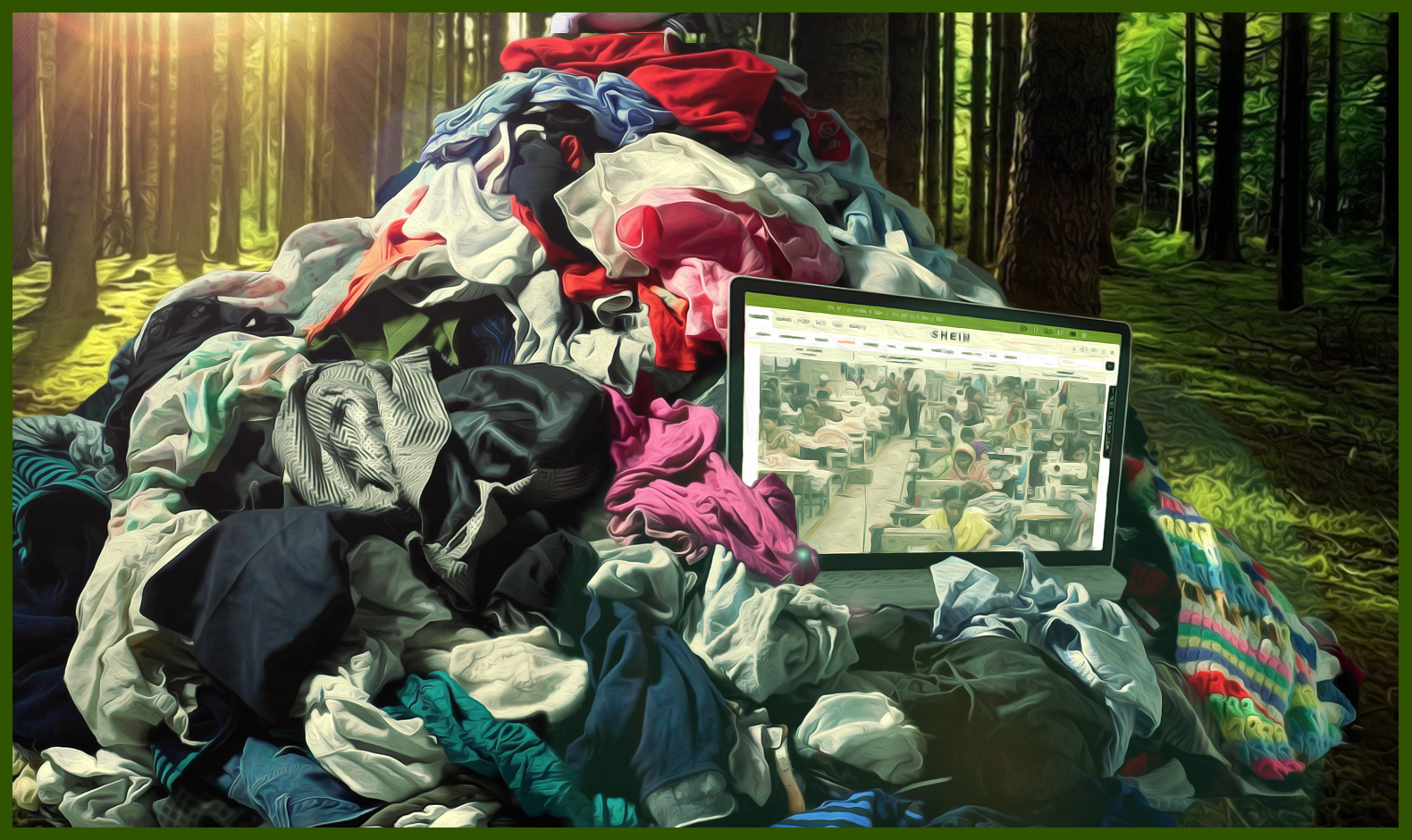Feminism 101: What is Greenwashing?

Design by Emma Lehman
Image description: A pile of clothes sits in a forest against a backdrop of sun streaming through trees. A laptop is nestled in the pile, showing an image on the SHEIN website of rows of women working at sewing machines.
Ads that claim sustainability are ubiquitous — an oil company declares themselves pioneers of environmental initiatives, a fast fashion company releases a “green” collection. Greenwashing, which The Guardian describes as “the corporate practice of making diverting sustainability claims to cover a questionable environmental record,” allows for businesses to portray themselves as environmentally conscious, thus appealing to a wider pool of consumers. Meanwhile, said corporations continue to practice hydraulic fracturing (“fracking”), foster unsafe labor conditions, and contribute overall to climate change. First coined in 1986, the term takes on a new relevance with the worsening reality of climate change. The consequences of unsustainable greenwashing companies are both environmental and human, with marginalized people at heightened risk for climate change-related disasters and smaller scale environmental risks caused by corporations.
Chevron, an oil company, recently posted a tweet reading, “We believe clean water is a fundamental societal, environmental, and economic resource. Because of that, we’re taking steps to responsibly conserve and protect water resources in the communities where we operate.”
Less than two months later, the company was responsible for a 600-gallon oil spill in Richmond, California. Oil companies attempt to hide their environmental impact behind green-themed ads, while continually causing oil spills and devastation in the communities where they reside. Corporations also attempt to downplay their environmental impact by highlighting goals of net zero emissions. Understanding the language corporations attempt to hide behind is essential — for example, net zero does not mean they aim to have zero emissions. Rather, they will attempt to offset said emissions via carbon removal (e.g. emission capture or reforestation). While net zero goals are better than nothing, the efficacy of carbon removal is compromised due to the scale of current greenhouse emissions. Thus, emissions must be reduced for carbon removal to be effective. Oil companies rely more on green advertising and responding to the environmental issues than they do on preventing harm.
Fast fashion brands, which strive to quickly respond to clothing trends at low prices, are unsurprisingly unsustainable. The practice encourages overconsumption (which results in consumers buying and disposing of clothing at increasing speed), resulting in increased levels of textile waste. The brands maintain their cheap costs by using unsustainable fibers and exploitative labor practices. Additionally, the fashion industry is responsible for 10% of global greenhouse emissions. In a New York Times book review entitled “How Fast Fashion is Destroying the Planet,” the author writes, “More than 60 percent of fabric fibers are now synthetics, derived from fossil fuels, so if and when our clothing ends up in a landfill (about 85 percent of textile waste in the United States goes to landfills or is incinerated), it will not decay.” While fast fashion brands such as H&M and SHEIN have dedicated “green collections” and/or “social responsibility” pages on their respective websites, their greenwashing practices reveal that those statements are just that — words. Both companies, alongside similar fast fashion brands such as Forever 21, Fashion Nova, and more, continue to utilize synthetic fibers (with the exception of their dedicated “green” collections) to keep costs low. True to the definition of greenwashing, they want to retain environmentally conscious consumers without truly changing their production standards.
Any discussion of climate change which fails to address the disproportionate impact on marginalized communities is, at best, incomplete. As the NAACP states on their website, “Race is the number one indicator for the placement of toxic facilities in the [United States].” An article from Princeton further breaks down the various forms taken by environmental racism, with the authors explaining that over one million Black people in the United States face increased cancer risk due to air pollution, and more than 6.7 million live in one of the 91 US counties with oil refineries. As oil companies release Youtube videos and ads about their dedication to protecting communities and encouraging sustainability, Black Americans are actively poisoned by said corporations. While fast fashion companies release green collections (such as H&M’s “conscious collection”) and tout “social responsibility statements” (SHEIN), they fail to pay their workers a living wage (e.g. Fashion Nova’s usage of LA based sweatshops), continually utilize unsustainable fast fashion models of production, and use unsustainable fibers outside of their “green” collections. While they may speak the language of sustainability, they do not practice it.
Also worth noting is that greenwashing exists beyond oil companies and fast fashion brands. Various other corporate industries (from food brands to SeaWorld) adopt the practice to seem eco-friendly. While large corporations label themselves as “green,” people, communities, and ecosystems are suffering.
Though large corporations are ultimately culpable for the impacts of greenwashing and unsustainable modes of production, willing consumers can take small steps to transform their own habits and hold corporations and governments accountable. Email your favorite clothing brand and inquire about their supply chain practices, encourage them to embrace recycled fibers, and ask about clothing recycling programs. Call out corporations when their greenwashing falls short of long-term, sustainable change. Advocate for environmental legislation and the Landback movement for Indigenous sovereignty. When possible, try and avoid shopping from fast fashion companies by buying secondhand or investing in pieces from more conscious brands (find an overview of ethical and sustainable brands here, Black-owned sustainable shops here, size inclusive shops here, and/or search up your favorite brand’s ethical and sustainability ranking via Good On You). When divesting from fast fashion is not an option, reject the goals of fast fashion by learning to mend your own garments, and try not to purchase more than you need (even if you plan on donating your excess clothes, your donations may end up shipped overseas rather than reworn). Most importantly, hold corporations and your government accountable for adopting and following sustainability goals — even when doing so would be inconvenient for them.




